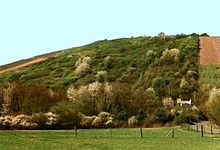Fallow vineyards

Vineyard fallow or fallow vineyard is a vineyard area that has been temporarily or permanently withdrawn from use.
Natural succession process
On fallow vineyards, the natural vegetation development begins with the abandonment of use . Depending on the location , this can take place differently. Permanently unused fallow vineyards in Germany ultimately develop into forests . A common pioneer society in fallow vineyards is the compass lettuce ( Lactucetum serriolae ). It is often replaced by permanent oat grass ( Inulo-Arrhenateretum ). The oat acts as a debris dam and makes it difficult for the wood to develop due to a pronounced litter felt. This usually takes place vegetatively through the formation of runners from the edges. However, young woody growth can also develop in the protection of deposited clippings. Fallow vineyards can be very species-rich and are not infrequently the only natural areas in intensively used vineyards . Warmth-loving species have often found a habitat in sun-exposed fallow vineyards on steep slopes . These can be species that have their distribution center in the Mediterranean area or in southern France, such as. B. the Zippammer in the middle Moselle valley. With increasing age of the fallow vineyards, the vegetation also reduces soil erosion and enables soil formation to begin again. In addition, the superficial runoff is reduced compared to vineyards without soil vegetation.
Fallow land as a soil recovery measure
In contrast to permanent use, which is usually due to a lack of profitability on small, impassable or very steep vineyards, targeted fallow vineyards have economic advantages for the winemaker and are only temporary.

After the vines have been cleared and loosened, replanting does not take place immediately, but one or more fallow years are pushed in between. This has the advantage that the nematodes that are harmful to the vines in the soil are reduced and the soil fatigue that has built up on one side due to the longstanding (mono) cultivation is reduced. Deep loosening measures can also be carried out over a large area. Most recovery plants are as bitter lupine, radish , alfalfa sown or grasses that simultaneously loosen the soil and of course his humus out. After the soil has been loosened again ( trenches ) at the end of the fallow period, young vines are planted.
legal framework
From a legal point of view, in Germany there may be a maximum of 13 years fallow time between clearing and replanting, otherwise the replanting right expires. Alternatively, if the area is intended to be used, it can be transferred to other vineyards. A transfer is only possible within a growing area; if the transfer does not take place internally, it can also be sold to other wineries. A transfer of planting rights is always subject to approval and is bound by certain conditions. The new plot of land to be planted must be climatically wine-growing and only the maximum area size of the new plot of land that corresponds to the cleared old area can be planted. A transfer from steep to flat areas is only permitted in exceptional cases. In viticulture, the term Driesche or Weingarten- or Weinbergdriesche is a vineyard that has been planted for at least two years, but is not cultivated and therefore overgrown. Pests such as phylloxera and diseases such as black rot of the vine can spread in them. Therefore, they represent a threat to the surrounding cultivated vineyards and it is a forced clearing , meaning the complete removal of the vine plants from the fallow land, prescribed by Drieschen. Phylloxera is increasing again due to the EU-funded final closure of vineyards in connection with the lack of or inadequate clearance .
See also
literature
- Michael Fiegle: fallow vineyards in the right-hand Moselle tributary valleys in the city of Trier . In: Communications from Pollichia . tape 90 . Bad Dürkheim 2003, p. 121-142 .
- Gerhard Hard: Grazed vineyards. On the syntaxonomy of the “grass stage” on vineyards in the Ahr and Middle Rhine Valley . In: Decheniana . tape 133 . Bonn 1980, p. 1-5 .
Web links
- Drieschen clearing costs money. Black rot and Drieschen: TV interview with Hubert Friedrich, Head of the Service Center Mosel (DLR). August 17, 2004, accessed December 28, 2015 .

